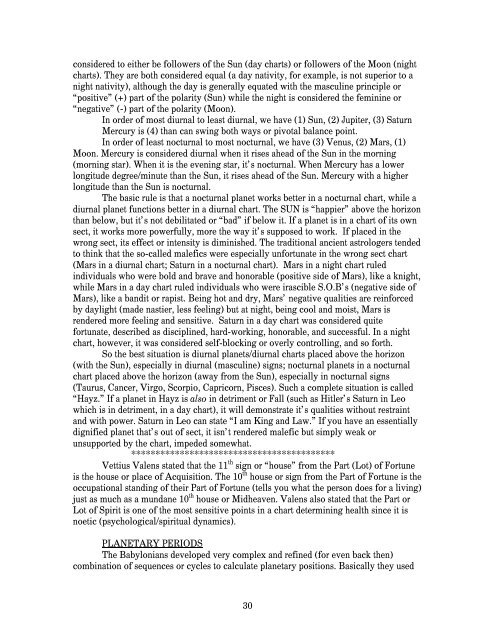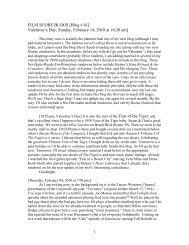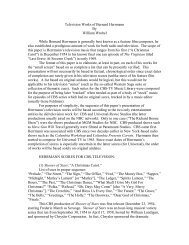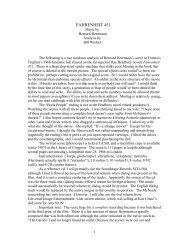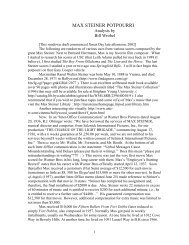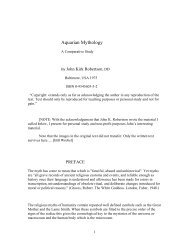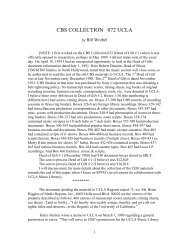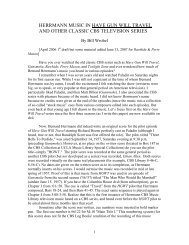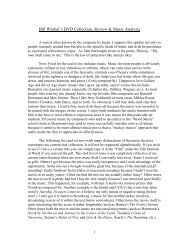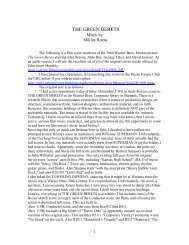OFF-TOPIC BONUS : ASTROLOGY # 2 - Film Score Rundowns
OFF-TOPIC BONUS : ASTROLOGY # 2 - Film Score Rundowns
OFF-TOPIC BONUS : ASTROLOGY # 2 - Film Score Rundowns
Create successful ePaper yourself
Turn your PDF publications into a flip-book with our unique Google optimized e-Paper software.
considered to either be followers of the Sun (day charts) or followers of the Moon (night<br />
charts). They are both considered equal (a day nativity, for example, is not superior to a<br />
night nativity), although the day is generally equated with the masculine principle or<br />
“positive” (+) part of the polarity (Sun) while the night is considered the feminine or<br />
“negative” (-) part of the polarity (Moon).<br />
In order of most diurnal to least diurnal, we have (1) Sun, (2) Jupiter, (3) Saturn<br />
Mercury is (4) than can swing both ways or pivotal balance point.<br />
In order of least nocturnal to most nocturnal, we have (3) Venus, (2) Mars, (1)<br />
Moon. Mercury is considered diurnal when it rises ahead of the Sun in the morning<br />
(morning star). When it is the evening star, it’s nocturnal. When Mercury has a lower<br />
longitude degree/minute than the Sun, it rises ahead of the Sun. Mercury with a higher<br />
longitude than the Sun is nocturnal.<br />
The basic rule is that a nocturnal planet works better in a nocturnal chart, while a<br />
diurnal planet functions better in a diurnal chart. The SUN is “happier” above the horizon<br />
than below, but it’s not debilitated or “bad” if below it. If a planet is in a chart of its own<br />
sect, it works more powerfully, more the way it’s supposed to work. If placed in the<br />
wrong sect, its effect or intensity is diminished. The traditional ancient astrologers tended<br />
to think that the so-called malefics were especially unfortunate in the wrong sect chart<br />
(Mars in a diurnal chart; Saturn in a nocturnal chart). Mars in a night chart ruled<br />
individuals who were bold and brave and honorable (positive side of Mars), like a knight,<br />
while Mars in a day chart ruled individuals who were irascible S.O.B’s (negative side of<br />
Mars), like a bandit or rapist. Being hot and dry, Mars’ negative qualities are reinforced<br />
by daylight (made nastier, less feeling) but at night, being cool and moist, Mars is<br />
rendered more feeling and sensitive. Saturn in a day chart was considered quite<br />
fortunate, described as disciplined, hard-working, honorable, and successful. In a night<br />
chart, however, it was considered self-blocking or overly controlling, and so forth.<br />
So the best situation is diurnal planets/diurnal charts placed above the horizon<br />
(with the Sun), especially in diurnal (masculine) signs; nocturnal planets in a nocturnal<br />
chart placed above the horizon (away from the Sun), especially in nocturnal signs<br />
(Taurus, Cancer, Virgo, Scorpio, Capricorn, Pisces). Such a complete situation is called<br />
“Hayz.” If a planet in Hayz is also in detriment or Fall (such as Hitler’s Saturn in Leo<br />
which is in detriment, in a day chart), it will demonstrate it’s qualities without restraint<br />
and with power. Saturn in Leo can state “I am King and Law.” If you have an essentially<br />
dignified planet that’s out of sect, it isn’t rendered malefic but simply weak or<br />
unsupported by the chart, impeded somewhat.<br />
******************************************<br />
Vettius Valens stated that the 11 th sign or “house” from the Part (Lot) of Fortune<br />
is the house or place of Acquisition. The 10 th house or sign from the Part of Fortune is the<br />
occupational standing of their Part of Fortune (tells you what the person does for a living)<br />
just as much as a mundane 10 th house or Midheaven. Valens also stated that the Part or<br />
Lot of Spirit is one of the most sensitive points in a chart determining health since it is<br />
noetic (psychological/spiritual dynamics).<br />
PLANETARY PERIODS<br />
The Babylonians developed very complex and refined (for even back then)<br />
combination of sequences or cycles to calculate planetary positions. Basically they used<br />
30


